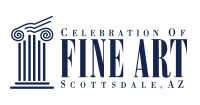“Nobody is visually naive any longer. We are cluttered with images, and only abstract art can bring us to the threshold of the divine.” ~ Dominique de Menilm, well-known philanthropist, activist, and art collector.
Of course, the art world did not always see things the way Dominique did. The Impressionists, who sought to capture light, were considered radicals in their day. But today, many artists explore the line between realism and abstraction in their work.
In this Art Discovery, artists Bruce Marion, Stuart Yankell, Aileen Frick and Martin Blundell discuss the interplay between representational work and the improvisation with color, texture, and shape that categorizes abstract art.
What is interesting to note is that none of the panelists set out to be abstract artists. In fact, Bruce Marion recalls his disdain for abstract art when he pursued his fine art degree in college. In his youth, he believed that abstraction was a cover for those who simply did not have the talent to approach representational work.
However, as the years have gone on, his perspective has shifted greatly. He says, “Every painting, whether photo realistic or abstract is still a bunch of abstract shapes. Once you learn to see those and manipulate those, and manipulate the color for strength and power, it just improves all of your paintings.”
Stuart Yankell also sees a profound connection between abstraction and realism. He recalls his first foray into abstract art: “When I first tried pure abstract painting it sort of reminded me of writing a poem. Because in a way you don’t have anything to hold onto. You’re relying on your instinct and making the painting come to peace just by the raw elements of the language.”
All of the panelists echoed the sentiment that abstract art is a way to explore the most essential elements of artistic creation. And while abstract has an enigmatic nature, its viewers can still be deeply moved by it, regardless of whether it is an abstract art canvas or another type of structural design.
For mixed media artist Aileen Frick, she adds another layer of abstraction to her work by combining collaged paper with paint over the collage to create abstracted city scapes. She notes, “I never really thought about my work as abstract because, in my mind, it’s pretty realistic. But if you were to look at it up close it’s all pieces of magazines. And a lot of times they tell stories….they tell a story that’s bigger than me. And that’s why I love the process.” For her, the abstraction comes less in the representation and more in the message of the piece.
Landscape painter Martin Blundell also explores abstraction as a part of his process: “I’m at the intersection of reality and memory.” His process is to take photographs, and then move to the studio to draw studies before putting brush to canvas. About two-thirds of the way through, he abandons his research materials and finishes the painting by memory. It’s in this liminal space between the present and past that the abstraction in his work is born.
To hear more from this panel about their exploration of figure, color, depth, texture, and balance on the canvas, watch the full Art Discovery below. And to learn even more about our featured artists, check out the following links:
Bruce Marion:
Martin Blundell:
Aileen Frick:
Stuart Yankell:

